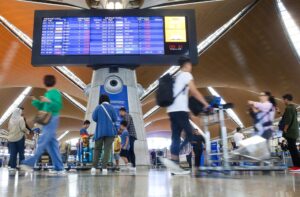KUALA LUMPUR, Aug 31 — Every August a familiar rhythm pulses through Malaysians.
You hear it at school assemblies, on the radio, in supermarkets, and again in viral clips on TikTok.
It is the soundtrack of Merdeka — a collection of patriotic songs that do more than just mark a holiday. They tell the story of a nation.
Each song is a time capsule, capturing Malaysia’s hopes, struggles, and evolving identity at a specific moment in history. Let us trace the journey of these songs, from solemn pledges to pop anthems.
1957: The Foundation — Negaraku
The story begins not in 1957, but in the 19th century. The melody of Negaraku has a surprisingly global heritage. It was originally the Perak state anthem, Allah Lanjutkan Usia Sultan, which itself was adapted from a popular Indonesian folk song, Terang Boelan.
That tune, in turn, is believed to have roots in the 19th-century French love song La Rosalie, brought to South-east Asia by travelling musicians.
Upon independence, this melody was chosen for its dignified air. A committee led by Tunku Abdul Rahman himself selected it and commissioned new lyrics. The resulting anthem, Negaraku, was more than a song; it was a sonic symbol of a new sovereign nation, a call for unity and divine blessing for the King and country.

The Google ‘doodle’ celebrating the birthday of the late artist Sudirman Arshad that was published on May 25, 2019. He died in February 1992, aged 37, due to pneumonia. — Screengrab via Google Doodles
1957: The date etched in song — Tanggal 31
If Negaraku is the soul of the nation, Tanggal 31 is the heartbeat of the celebration. Its origin story is a testament to the pan-Malayan spirit. The song was composed by Ahmad Chass Barra (Ahmad C.B.), an Indonesian-born songwriter who was so inspired by the news of Malaya’s impending independence that he put pen to paper from across the sea.
Its genius lies in its simplicity. The lyrics are a direct, triumphant announcement:
“Tanggal tiga puluh satu, bulan lapan, lima puluh tujuh… Merdeka! Merdeka! Tetaplah merdeka, ia menjadi sejarah.”
In 1982, the nation’s beloved Datuk Sudirman Arshad supercharged the tune. His iconic pop rendition, complete with a children’s choir and his own energetic whistling, transformed it from a commemorative piece into the rousing, irresistible anthem we know today.
The 1960s: Forging unity — Malaysia Berjaya
The early 1960s were a period of immense change, with the formation of Malaysia in 1963 and the subsequent Konfrontasi with Indonesia. To strengthen national bonds, the government launched National Unity Week in 1964.
The theme song, Malaysia Berjaya, was composed by Saiful Bahri Elyas (who also worked on the lyrics for Negaraku). Its marching rhythm and optimistic lyrics — “Satu bangsa, satu bahasa… Dari Perlis sampai ke Sabah” — were a direct call for solidarity, promoting the idea of a single, prosperous nation stretching from the northernmost to the easternmost states.
1970s and 1980s: Setia and Sejahtera Malaysia
Following the racial tensions of 1969, the tone of patriotic music shifted. The goal was no longer just celebration, but healing and fostering unwavering loyalty.
This era produced two classroom staples. Sejahtera Malaysia became a ceremonial wish for harmony and stability, often performed at official events. Setia, famously sung by Francissca Peter, was a powerful ballad commissioned by the government.
Its lyrics were a direct pledge: “Setia, setia, setia… kepada negara” (Loyal, loyal, loyal… to the country), teaching a generation that patriotism meant steadfastness through both good times and bad.
The 1990s and the vision for the future — Wawasan 2020
Driven by Prime Minister Tun Dr Mahathir Mohamad’s ambitious Vision 2020, the nation looked forward, and patriotic music followed suit. The anthems of this era, like Wawasan 2020, were less about reflection and more about aspiration.
They were motivational rallying cries, urging Malaysians to embrace progress, modernisation, and unity to achieve developed nation status.

Pak Ngah the legendary composer passed away in 2018. The composer was known as the father of Irama Malaysia who popularised the form of traditional music. — Picture via Instagram/@pakngahmemorial
1997–2003: New flag, new anthem — Jalur Gemilang
In 1997, the national flag was officially given a name: “Jalur Gemilang” (Stripes of Glory). This demanded an anthem worthy of its symbolism.
The task fell to legendary composer Datuk Suhaimi Mohd Zain (Pak Ngah), with lyrics by Siso Kopratasa. The resulting song, officially launched in 2003, is a masterclass in patriotic imagery. It does not just praise the flag; it decodes it:
“Merahmu bara semangat waja” (Your red is the ember of courageous spirit)
“Putihmu bersih budi pekerti” (Your white is pure character)
“Biru perpaduan kami semua” (Blue is our unity)
Jalur Gemilang was the anthem for a modern, confident Malaysia, ready to claim its place on the global stage.
2000s to today: Patriotism in pop — Keranamu Malaysia and beyond
Patriotism entered the age of mass media. Songs like Keranamu Malaysia (Because of You, Malaysia), also composed by Pak Ngah, dominated television airwaves, often soundtracking montages of scenic landscapes and diverse, smiling citizens. It emphasised gratitude and love for the country’s peace and prosperity.
Today, the tradition is alive and evolving. Superstars like Siti Nurhaliza, Faizal Tahir, and Joe Flizzow regularly release Merdeka specials, blending traditional elements with pop, rock, and hip-hop.
Tanggal 31 and Negaraku are constantly reimagined — from soulful orchestral arrangements to electronic TikTok remixes — proving that these songs are living, breathing artefacts of national culture.





